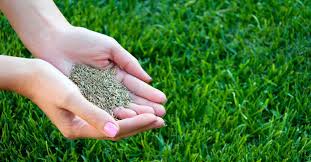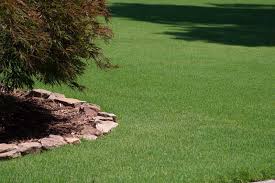Warm Season Grasses are special group of grasses that thrive in warm weather. These types of grasses are the happiest when the sun is shining and the temperatures are high. Unlike some other grasses that enjoy cooler conditions, warm season grasses really enjoy the heat.
When we talk about warm season grasses, we’re talking about a variety of plants that have a few things in common. They tend to grow best in places where the weather is warm and can even be a bit on the hot side. These grasses are well-suited for regions with a tropical or subtropical climate.
There are different kinds of warm season grasses, each with its own unique features. Some examples include Bermuda grass, Zoysia grass, and St. Augustine grass. You might find these types of grasses in lawns, parks, and even sports fields. They have strong roots that help them stay green and healthy even when it’s really warm outside.
The interesting thing about warm season grasses is that they have a particular pattern of growth. They usually start growing more actively in late spring or early summer, just when the weather is getting warmer. These grasses love the heat, and they become most vibrant during the hottest months of the year.
When the weather starts to get colder, these grasses might slow down and even turn brown. This is like their way of taking a nap during the colder months. It’s completely normal, and they’ll wake up again when the temperatures start to rise.
One of the advantages of warm season grasses is their ability to handle dry conditions. They’re quite tough and can survive with less water compared to some other types of grass. However, during long periods of drought, it’s a good idea to give them a little extra water to keep them looking their best.
If you live in a place where the weather stays warm for a large part of the year, warm season grasses could be an excellent choice for your outdoor spaces. Just remember that these grasses appreciate warmth and sunshine, so make sure they get plenty of both.
Read Also: Guide to Catching and Holding of Sheep and Goats Easily
Types of Warm Season Grasses

There are several types of warm season grasses, each with its own characteristics and benefits. Here are a few common ones:
1. Bermuda Grass: Bermuda grass is known for its fine texture and ability to tolerate heavy foot traffic. It’s often used on sports fields and golf courses. It can go dormant and turn brown during winter but quickly regains its green color in warmer months.
2. Zoysia Grass: Zoysia grass is popular for its dense growth and ability to create a lush carpet-like lawn. It’s known for its drought tolerance and can handle a variety of soil types. Zoysia grass also has good shade tolerance compared to other warm season grasses.
3. St. Augustine Grass: St. Augustine grass is a coarse-textured grass that grows well in warmer coastal areas. It has a deep green color and is often used in lawns. It prefers rich soils and can tolerate some shade.
4. Centipede Grass: Centipede grass is known for its low-maintenance requirements. It doesn’t need a lot of fertilizer and can thrive in acidic soils. It has a light green color and spreads through above-ground stolons.
5. Buffalo Grass: Buffalo grass is native to North America and is well-suited for areas with hot, dry climates. It’s a low-growing grass with a soft texture and is often used in natural, low-maintenance landscapes.
6. Bahia Grass: Bahia grass is known for its coarse texture and good drought resistance. It’s commonly used in pastures and lawns in warmer regions. Bahia grass can handle sandy soils well.
7. Carpet Grass: Carpet grass is a low-growing grass that’s suitable for low-traffic areas. It’s often used in wetter climates and poorly-drained soils. It can tolerate shade but may not perform well in extreme heat.
8. Seashore Paspalum: Seashore paspalum is often used in coastal areas due to its salt tolerance. It’s popular on golf courses and other sports fields near the ocean. It has a fine texture and deep green color.
These are just a few examples of warm season grasses, each with its own unique characteristics and advantages. When choosing a warm season grass for your lawn or outdoor space, consider factors like climate, soil type, shade tolerance, and maintenance requirements.
Where to Find Warm Season Grass near Me/You
You can find warm season grasses at various places, depending on your needs and location:
1. Nurseries and Garden Centers: Local nurseries and garden centers often carry a variety of warm season grass seeds, plugs, or sod. They can provide guidance on which grass types are best suited for your area and how to care for them.
2. Online Retailers: Many online retailers specialize in selling grass seeds, plugs, or sod. You can browse their websites, read reviews, and select the warm season grass variety that matches your preferences.
3. Landscaping Suppliers: Landscaping supply stores might offer warm season grass products, especially if you’re looking to cover a larger area. They may have bulk options for seeds or sod.
4. Farm and Agricultural Supply Stores: If you’re looking for warm season grasses for larger properties or pastures, farm supply stores might carry the seeds or sod you need.
5. Local Farmers: Sometimes local farmers or agricultural organizations host sales or events where they offer grass seeds or plugs, particularly if you’re looking for warm season grasses suitable for larger landscapes.
6. Lawn and Garden Shows: Attend local lawn and garden shows, fairs, or expos. These events often have vendors selling grass-related products, including warm season grass varieties.
7. Landscape Professionals: Landscape companies might have access to different warm season grass options. If you’re considering a larger landscaping project, they can help you choose and install the right grass type.
8. Local Extension Offices: Agricultural extension offices or university cooperative extension programs might have resources and information about where to find warm season grasses in your region.
9. Home Improvement Stores: Some larger home improvement stores may carry grass seeds, especially during the gardening season.
10. Community Plant Exchanges: Some communities host plant exchange events where local gardeners share plants, including grass varieties.
Before purchasing warm season grasses, it’s important to research and choose the right type for your climate, soil conditions, and intended use. Local experts, such as nursery staff or agricultural extension agents, can provide valuable advice to ensure successful growth.
Read Also: Sheep Production Process Complete Guide
Uses of Warm Season Grasses

Warm season grasses have various uses in different settings due to their ability to thrive in warm and hot climates. Here are some common uses for warm season grasses:
1. Residential Lawns: Warm season grasses are frequently used in residential lawns, creating lush, green outdoor spaces that can withstand the heat of summer. Varieties like Bermuda grass, Zoysia grass, and St. Augustine grass are popular choices for homeowners.
2. Parks and Recreational Areas: Many public parks and recreational areas feature warm season grasses. These grasses can handle heavy foot traffic and still maintain their appearance, making them suitable for picnics, sports, and other outdoor activities.
3. Sports Fields: Warm season grasses are commonly used on sports fields, including soccer fields, football fields, and golf courses. Their durability and ability to recover from wear and tear make them well-suited for athletic use.
4. Golf Courses: Golf course fairways and tees often feature warm season grasses like Bermuda grass or Zoysia grass. These grasses provide a consistent playing surface that can withstand the demands of golfing.
5. Commercial Landscaping: Warm season grasses are used in commercial landscaping to create attractive outdoor areas around businesses, office complexes, and shopping centers. They provide a welcoming appearance while being well-suited for the local climate.
6. Erosion Control: Some warm season grasses, such as Buffalo grass and Bahia grass, are used for erosion control on slopes and hillsides. Their deep root systems help stabilize the soil and prevent erosion.
7. Recreational Turf: Warm season grasses are ideal for creating recreational turf areas such as playgrounds, dog parks, and community gathering spaces. They can handle regular use while maintaining their visual appeal.
8. Land Reclamation: In areas with disturbed or degraded soils, warm season grasses can be planted to restore the land’s natural vegetation and prevent soil erosion.
9. Pastures and Grazing: Warm season grasses like Bahia grass are commonly used for grazing animals in warmer climates. These grasses provide nutritious forage for livestock.
10. Conservation and Restoration: Some warm season grasses are used in conservation and restoration efforts to reestablish native plant communities in natural habitats.
11. Roadside Landscaping: Warm season grasses can be used in roadside landscaping projects to beautify roadsides and medians while requiring less water than traditional landscaping.
12. Drought-Tolerant Landscaping: Warm season grasses are often chosen for water-efficient landscaping projects in areas prone to drought. They can reduce water consumption while still providing an attractive outdoor environment.
In each of these settings, choosing the right warm season grass species and cultivar is important to ensure successful establishment and maintenance. Different grasses have varying levels of shade tolerance, water requirements, and maintenance needs, so it’s essential to match the grass type with the specific use and conditions of the location.
Read Also: Waste Management Startups: The Future of Sustainable Waste Management
